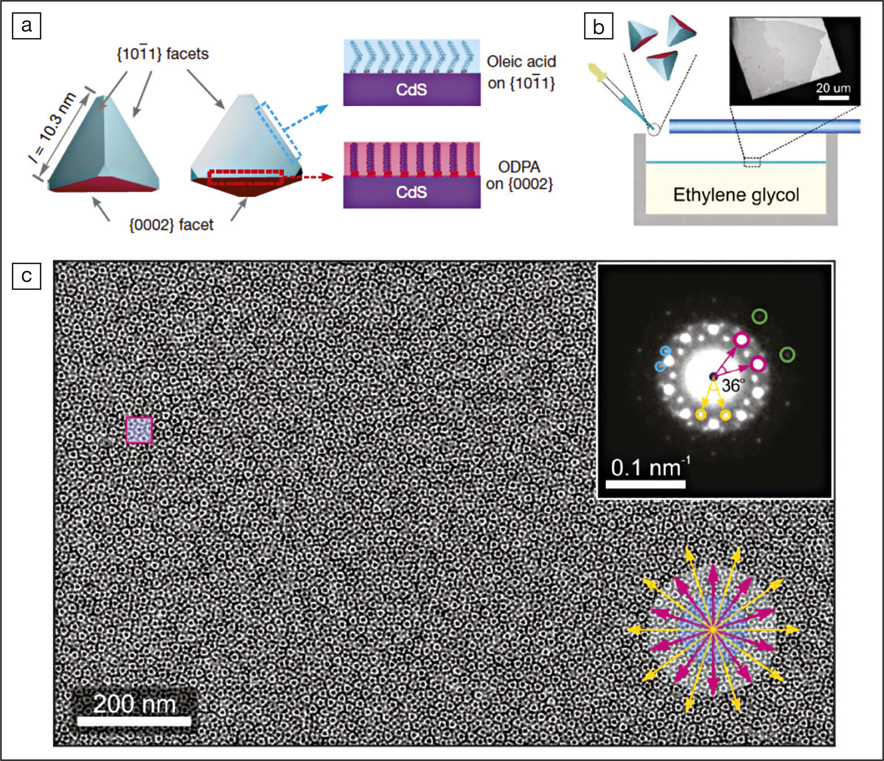Quasicrystalline structures—discovered by Dan Shechtman to break classic crystallographic principles by exhibiting tenfold rotational symmetry—have been further explored with great rigor. A recurring theme in experimental demonstrations has been the fact that more than one distinct component is needed as the building block to form quasicrystals. For example, bimetallic nanocrystals have been successfully arranged in quasicrystalline superlattices (QCSLs). Quasicrystals made out of single building blocks have only been theoretically predicted using computer simulations thus far. A research group at Brown University led by Ou Chen has now demonstrated quasicrystals made out of a single-component building block. The results were recently published in Science (doi.org/10.1126/science.aav0790).

(a) Patchy truncated tetrahedral quantum dots (TTQDs) used for formation of quasicrystalline superlattices (QCSLs) (credit: Nature). ODPA is octadecylphosphonic acid. (b) Controlled evaporation of the TTQD colloidal solution in cyclohexane on the non-interacting liquid subphase of ethylene glycol; and (c) transmission electron microscope image of tenfold QCSLs. Credit: Science, AAAS.
Classical crystallography is based on the foundational theorem that crystals can only exhibit two-, three-, four-, and six-fold rotational symmetries. A pattern with any of these symmetries will have translational periodicity, a prerequisite for a crystalline state. Particles arranged in any other configuration will lack translational symmetry and so will not be crystals, as per the original definition. In the early 1980s, however, Shechtman made his startling discovery that certain alloys of aluminum and manganese formed quasicrystalline structures that flouted this basic rule of crystallography. This discovery marked a breakthrough in current understanding on how matter packs at the atomic scale and it redefined the field of crystallography.
The single building block to form quasicrystals is a special kind of nanocrystal, the synthesis of which was reported by the same group last year in Nature (doi:10.1038/s41586-018-0512-5). Core–shell quantum dots (or nanocrystals) with the shape of truncated tetrahedra were synthesized using a commonly used hot-injection method and a core–shell growth method. This is an interesting choice of quantum dot shape as most previous studies looked at spherical or near-spherical geometries. Having found earlier that their truncated tetrahedral quantum dots (TTQDs) self-assembled into exciting and complex superstructures when the colloid was left to dry on a rigid silicon substrate, the research team was interested in understanding how increased interparticle interaction would modify the self-assembly.
To this end, the researchers carefully dropped the TTQD colloidal solution (in cyclohexane) atop a non-interacting liquid subphase (ethylene glycol) of different polarity. This helped the two liquid phases to avoid mixing and gave the TTQDs increased time to interact. Once the top phase evaporated, the dried structures were isolated and studied using x-ray scattering and electron microscopy. A thorough characterization of the structures showed that the TTQDs had, in fact, self-assembled into tenfold QCSLs. This was surprising since the TTQDs are single-component nanoparticles.
The normal practice during nanocrystal synthesis is to cover the surfaces with surfactants, the role of which is to impart colloidal stability to the nanocrystals and to enhance their optical properties by securing their surfaces from unwanted oxygen and moisture attack. One set of the surfaces of the TTQDs was intentionally covered with a different surfactant than the others. This surface-specific surfactant coating had crucial implications when TTQDs were allowed to interact during self-assembly. Surface facets with similar surfactants had enhanced affinity to come closer, enhancing self-assembly and leading to decagonal units. Importantly, it was found that during self-assembly, the decagons could flexibly share edges and transform into polygons of five to nine edges wherever necessary to fill gaps.
“The present work is a fascinating discovery on quasicrystalline assemblies from anisotropic nanocrystals,” says Xingchen Ye, an assistant professor of chemistry at Indiana University Bloomington, and an expert in quasicrystalline self-assembly. “The observed tenfold rotational symmetry is distinct from the dodecagonal symmetry predicted by computer simulations of assemblies of hard tetrahedra, motivating further investigations on how details of shape and interaction anisotropy encoded at the single-nanocrystal level lead to mesoscopic ordering.”
The demonstration of QCSLs from single-component building blocks enabled by the discovery of the “flexible polygon tiling rule” has opened a new realm in the field of quasicrystalline structures and will enrich the tool chest for chemical synthesis of superstructures. “We have demonstrated a fundamentally new type of quasicrystal. The decagons form quasicrystalline superlattices by making their edges flexible, utilizing our flexible polygon tiling rule,” Chen says. “Our findings have implications for research in materials science, chemistry, mathematics, and even art and design.”
Quantum dot superlattices are increasingly being explored for electronic and optoelectronic applications with claims of enhanced charge transport and optical properties due to increased order. The present study is anticipated to soon bring into view the exciting subfield of quantum dot QCSL electronics.


